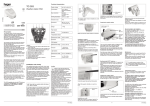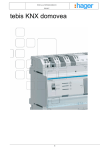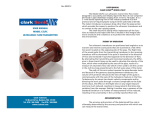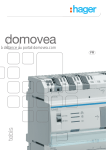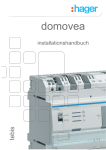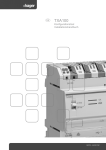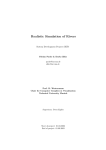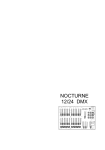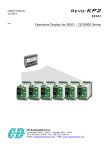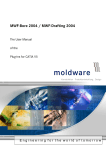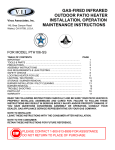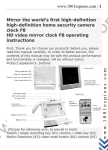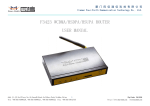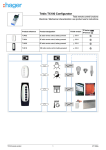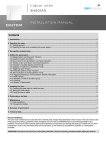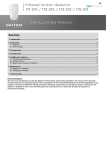Download Tebis application software
Transcript
Tebis application software LS alarm interface / TP KNX Electrical / Mechanical characteristics: see product user manual Product reference Product designation Application software ref. TRC120C LS alarm interface / TP KNX STRC120 domovea IP Radio or mixed alarm system Location of the interface in the radio alarm system / Tebis KNX System Tebis Web Interface TRC120 TwinBand RADIO KNX bus Media coupler R Touch screen KNX Summary 1. Description of the TRC120 interface................................................................................................................................. 2 1.1 Description................................................................................................................................................................... 2 1.2 Reminder: Alarm system glossary............................................................................................................................... 2 2. Operation: from the KNX bus to the radio alarm via the TRC120..................................................................................... 4 2.1 List of Receiver objects ............................................................................................................................................... 4 2.2 Parameters, Scene function and reset ........................................................................................................................ 6 3. Operation: from the radio alarm to the KNX bus via the TRC120..................................................................................... 7 3.1 List of Emitter objects .................................................................................................................................................. 7 3.2 Description of the parameters ..................................................................................................................................... 8 3.3 Storage of the scene by the TRC120 ........................................................................................................................ 10 4. Learning and Configuration............................................................................................................................................. 10 4.1 Physical addressing................................................................................................................................................... 10 4.2 Configuration ............................................................................................................................................................. 10 4.3 Domovea ................................................................................................................................................................... 11 5. Factory reset ................................................................................................................................................................... 12 6. Behaviour if the bus is cut off.......................................................................................................................................... 12 7. Main characteristics ........................................................................................................................................................ 12 TRC120C 1 6T 8079-02a 1. Description of the TRC120 interface The TRC120 interface is used to enable an intrusion alarm system from the LS range (radio or mixed central unit) to communicate with the KNX world. On the alarm side, the interface communicates with the alarm central unit by radio and by TP bus on the KNX side. It acts as an input/output product which includes: • 8 KNX outputs, these are KNX commands received by interface which are then transmitted to the alarm central unit, • 16 KNX inputs, this is alarm system status information sent from the central unit, to which KNX controls can be associated. 1.1 Description 1 2 3 4 5 6 7 traffic TP KNX LED (twisted part), signalling indicator red Programming pushbutton OK Programming pushbutton Antenna traffic RF LED radio alarm TwinBand (radio frequency), signalling indicator green 2 x 8 segment display Hatch EIB / KNX bus connection terminal R All the necessary for attachment Cable gland location How can we distinguish between the inputs and outputs on the TRC120 ? To distinguish the 16 inputs from the 8 outputs on the TRC120, the product display indicates the numbers respectively in the following way: • 1 to 16 for the inputs • 1° to 8° for the outputs 1.2 Reminder: Alarm system glossary Radio alarm controls or events Central unit Group X On / Off • Switching on or off of group X • Each control acts on the group concerned without modifying the status of the other groups Partially on 1 Start-up of group 1 only, the other groups switch off Fully on Start-up of all the groups Fully off All the groups are switched off Exit open Management of the status of exits remaining open Anomaly • Storage of voltage, self protection, cut telephone line, radio connection anomaly • Re-emission of system anomaly by the central unit whatever the status of the system TRC120C 2 6T 8079-02a System reactions Type of alarm Central unit Siren alarm bell Telephone transmission Low pre-alarm (Progression of the intrusion level 1) • 5 s audible beeps • Storage in the event log Low level NO Loud pre-alarm (Progression of the intrusion level 2) • 15 s alarm bell • Storage in the event log Low level or maximum power NO Intrusion or intrusion confirmed (*) • Maximum power alarm bell • Storage and vocal indication Maximum power YES Warning (Individual protection) • Maximum power alarm bell • Storage and vocal indication Maximum power YES Silent warning (Individual protection, Panic) • No alarm bell • Storage and vocal indication NO YES Fire alarm • Maximum power alarm bell for 5 min (Specific modulation) • Storage and vocal indication Specific modulation YES Technical alarm (Frost, Mains, Flooding, Freeze fault) • No alarm bell • Storage of the alarm • Voice indication of the detection NO YES (*) Intrusion confirmed = (Pre-alamr + Intrusion) or 2 consecutive intrusions For a detailed explaination of the operation of the alarm system, please consult the manual for the alarm central unit. TRC120C 3 6T 8079-02a 2. Operation: from the KNX bus to the radio alarm via the TRC120 In the direction Bus to alarm system, the interface can receive KNX controls to re-emit them by radio to the intrusion alarm central unit. System Tebis Interface TRC120 Radio or mixed alarm system KNX and / or domovea input modules RADIO CONTROL KNX TP bus 2.1 List of Receiver objects The following controls can be emitted by a KNX emitter to the alarm system via the TRC120 interface: • On / Off group 1 to 4 • Partially on • Silent warning • Fire alarm • Warning TRC120C 4 6T 8079-02a Input KNX and domovea modules Output (KNX command receiver) TP KNX bus Alarm radio Interface TRC120 KNX outputs 1 to 8 Alarm output functions Alarm CENTRAL UNIT Description: Radio alarm control Group 1 On / Off Media coupler Linking KNX Group 2 On / Off Group 3 On / Off Radio alarm control Group 4 On / Off Partially on 1 Silent warning (24 h / 24) Fire alarm (24 h / 24) Warning (24 h / 24) The objects listed above behave like KNX command receivers (Outputs KNX). A Receiver ON / OFF and / or Scene Object can be associated with each of these 8 controls. The group 1 to 4 on / off controls also have a Status indication emitter object. This indicates the real status of the group on the bus even if switching on or off is performed by an emitter from the alarm system. This indication is emitted immediately, without waiting for the alarm system input or output time delay to elapse. Delayed emission of the on / off by the TRC120 is available on the Group 1 to 4 on off status emitters or On status or Total shut-down objects. On and fully off To obtain the Fully on and Fully off controls (On or Off of all the central unit groups) the secure emitter (On or Off or On / Off function) must be connected to the 4 entitled On / Off group 1 to 4. With domovea, the default controls Fully on and Fully off are proposed which automatically associate the active groups of the central unit (2, 3 or 4 groups). Please consult the TRC120 manual for the configuration of the number of active groups. RECOMMENDATION Switching off the alarm central unit from any device must be performed in a secure manner with an access code, password or key. Products are installed and used under the sole responsibility of the installer and end customer. The manufacturer may in no way be held responsible in the event of damage linked to fraudulant or malicious use of the product. TRC120C 5 6T 8079-02a 2.2 Parameters, Scene function and reset Parameters: There are no parameters for the Receiver objects above. Scene function: When receiving commands, all the Scène objects are always set to ON. This parameter cannot be modified in ETS. The purpose of this restriction is to avoid an alarm indication being stopped or the total shutdown of the alarm sysetm by a scene type control. In the direction KNX to the alarm system, the Scene function will only allow the activation of the alarm groups or the reporting of an alarm or a warning. Reset: If the Silent warning, Fire alarm and Warning controls are emitted from aKNX emitter, a reset mechanism must be provided for the emitter so that the following indications are taken into account. TRC120C 6 6T 8079-02a 3. Operation: from the radio alarm to the KNX bus via the TRC120 In the direction alarm system to KNX bus, the interface can receive up to 16 statuses or alarm events transmitted by the alarm central unit. It is possible to associate KNX controls with these events to trigger a reaction on domovea or in the KNX installation: lighting, blinds or shutters, heating controls... The interface plays the role alarm event receiver and behaves as an input product (command emmitter) on the KNX side. Interface TRC120 Radio or mixed alarm system System Tebis KNX and / or domovea output modules STATUS OR RADIO EVENT KNX TP bus 3.1 List of Emitter objects The KNX objects corresponding to the 16 items of status information (from "Group 1 On / Off status" to "Technical alarm status") and the associated parameters are always identical. For each of these items of information, the associated object will be selected in the "Parameters" view from one of the following 6 functions: ON / OFF, Shutters / blinds, Heating, Priority, Scene or Timer. Processing of the various items of information from the central unit • Return of the system to On and Off status*: • The alarm system is returned to on status at the end of the central unit output time delay, • The alarm system is returned to off status at the end of the central unit input time delay, • With domovea, it is possible to interrogate the system to find out the current status of groups 1 to 4. • Exit open: When the system is switched on, the status of the exits is stored (deleted when the alarm system is next switched off). • Anomaly: When the system is switched on or off, the anomalies are stored (deleted when the alarm system is next switched on). • Low pre-alarm / Loud pre-alarm / Intrusion / Intrusion confirmed / Warning / Silent warning / Fire alarm / Technical alarm: On switching off, the alarms are stored (delected when the alarm system is next switched on). * The "on and off" statuses of the central unit can also be reported immediately if no input and / or output time delay is programmed on the central unit. TRC120C 7 6T 8079-02a 3.2 Description of the parameters In the Configuration screen, it is the choice of function which will determine the type of object available (See the example below with the Group 1 On / off status object). Parameters Function Corresponding object Value on reception of alarm event Name Function Not used Default value: Not used ON / OFF OFF / -, ON / -, OFF / ON, ON / OFF Group 1 On / Off status ON / OFF Shutters / blinds Up, Down, Up / Down, Down / Up Group 1 On / Off status Up / Down Heating Comfort / Night set-point, Comfort, Night setpoint, Frost protection / Auto, Frost protection, Auto, Standby, Comfort / Standby Group 1 On / Off status Set point selection Priority Priority ON / Down / Comfort, Priority OFF / Up / Frost protection Group 1 On / Off status Priority Scene Scene 1 to 32 Group 1 On / Off status Scene Timer No duration parameters (to be adjusted on the output) Group 1 On / Off status Timer Setting parameters ■ Function ON / OFF This function is used to switch the lighting circuit or any other load ON or OFF. The control is sent by the ON / OFF object must be defined in the parameters. • ON / -: Emission of the ON control upon reception of the event transmitted by the alarm central unit to the TRC120 (E.g. start-up of group 1, • OFF / -: Emission of the OFF control upon reception of the corresponding event, no action when the event disappears, • OFF / ON: Emission of the OFF control upon reception of the event, ON emmission when the corresponding event disappears, • ON / OFF: Emission of the ON control upon reception of the event, emission of OFF when the corresponding event disappears. ■ Shutter / blinds functions This function controls shutters and blinds. The command to be sent by the Up / Down object must be defined in the parameters. • Up: Emission of the Up control upon reception of the event, no action when the event disappears, • Down: Emission of the Down command upon reception of the event, no action when the event disappears, • Up / Down: Emission of the Up control upon reception of the event, emission of the Down control when the corresponding event disappears, • Down / Up: Emission of the Down control upon reception of the event, emission of the Up control when the corresponding event disappears. ■ Heating function This function is used select a heating setpoint. The setpoint to be sent by the Setpoint selection object must be defined in the parameters. • Comfort / Night set-point: Emission of the Comfort object upon reception of the event, emission of Reduced when the corresponding event disappears, • Comfort: Emission of the Comfort setpoint upon reception of the corresponding event, no action when the event disappears, • Night set-point: Emission of the Reduced setpoint upon reception of the corresponding event, no action when the event TRC120C 8 6T 8079-02a • • • • • disappears, Frost protection / Auto: Emission of the Frost protection setpoint upon reception of the event, emission of Auto when the corresponding event disappears, Frost protection: Emission of the Frost protection setpoint upon reception of the corresponding event, no action when the event disappears, Auto: Emission of the Auto setpoint upon reception of the corresponding event, no action when the event disappears, Standby: Emission of the Economy setpoint upon reception of the corresponding event, no action when the event disappears, Comfort / Standby: Emission of the Comfort setpoint upon reception of the event, emission of Economy when the corresponding event disappears, ■ Priority function This function sends priority-start or priority-stop commands. No other command is taken into account if a priority is active. Only end of priority or alarm commands will be taken into consideration. The priority action depends on the type of appplication controlled: lighting, rolling shutters, heating. The priority control to be sent by the Priority object must be defined in the parameters. • Priority ON / Down / Comfort: Emission of Priority On - Down - Comfort upon reception of the corresponding event, cancelling of this priority when the event disappears, • Priority OFF / Up / Frost protection: Emission of priority OFF - Up - Frost protection upon reception of the corresponding event, cancellation of this priority when the event disappears. ■ Timer function This function operates like a staircase light function. The commands are sent by object Timer. The timer duration is set on the output module. • Timer: Emission of the timer control upon reception of the corresponding event, no action when the event disappears. ■ Scene function: Scene N° 1 to 32 The Scene function sends group controls to different kinds of outputs to create ambiences or scenarios (Panic switch, television, etc.). The value of the Scene object is defined by the choice of the scene number. • Scene N° x: Emission of the scene N° x upon reception of the corresonding event, no action when the event disappears. TRC120C 9 6T 8079-02a 3.3 Storage of the scene by the TRC120 Configuration of the scenes can only be done after downloading the links between the TRC120 Scene emitter object and the outputs controlled by the scene. The procedure which follows is used to teach the outputs concerned by the scene the statuses to be restored as soon as the corresponding scene is activated by the TRC120. • Use the local controls to place the outputs concerned in the desired status (lighting on, lighting off, up, down, etc.), • Enter the scene configuration menu by pressing and holding the "+" key of the TRC120 until "Sc" is displayed, • Short successive presses on the "+" and "-" keys are used to search for and select the input number which activates the scene in question, • Pressing and holding the OK key for (5 s) leads to the scene being stored. The gateway confirms storage by causing "Sc" to flash on its display for a few seconds. 4. Learning and Configuration 4.1 Physical addressing Procedure for physical addressing of the TRC120: • Enter the physical addressing mode: Give a short press simultaneously on the and keys ➜ "Ad" is displayed on the TRC120. The product remains in programming mode until the physical address has been transmitted by ETS, • Exit the physical addressing mode manually: Give a short press simultaneously on the and keys. 4.2 Configuration On the KNX side, the TRC120 interface is a TP product remotely supplied by the KNX bus. Addressing, configuration and creation of links between the various KNX products is performed in accordance with the KNX standard. To allow dialogue between the alarm central unit and the TRC120 interface, the TRC120 must be learnt by the central unit (consult the TRC120 installation guide). ETS configuration of the TRC120 can be carried out before or after this learning. TRC120C 10 6T 8079-02a 4.3 Domovea The TRC120 interface allows the integration of the alarm functions in domovea (domovea version 2.5 or >). An ETS export procedure followed by an import in domovea will allow domovea to recover all the group addresses required for its configuration. Before performing the export, check that all the addresses required are correctly linked to a TRC120 Emitter or Receiver object. Export of the ETS group addresses • Export procedure from ETS 3 • Open the project including the TRC120 and then select: File menu / Save as CSV / XML • Select Export to the OPC server export • • Name the file: Name of the project.esf and save Export procedure from ETS 4 • Open the project including the TRC120 and then select Menu: Extras / Export OPC • Select Export to the OPC server export • Name the file: Name of the project.esf and save Recovery of the group addresses in domovea • Launch the domovea configurator then go to the menu: device • Click on: See the KNX data / Configured by ETS / import • Select the name of the project.esf file to be imported and click on open The group addresses with names can now be linked to domovea devices by simple drag and drop. Configuration of switching the central unit Fully On and Fully Off by domovea Domovea automatically proposes the Fully on and Fully off control. To do this, domovea uses the addresses of the individual on and off controls for each group and emits them in bursts to obtain fully on and fully off in accordance with the number of active groups declared on the central unit. It is therefore necessary to have an on / off group address for each of the groups taken individually. TRC120C 11 6T 8079-02a 5. Factory reset This function enables the device to be returned to its initial configuration (configuration when it came out of the factory). After a device reset, the device can be re-used in a new installation. • • Factory reset on the product Simultaneously press for more than 5 s on the and Factory reset by ETS Factory reset corresponds to the function • Unload in ETS 3 • Unload the application and address in ETS 4 keys until "FA" is appears on the display Factory reset causes the the product configuration to be completely deleted: • Deletion of the physical address and links made • Deletion of the address of the alarm central unit After a TRC120 factory reset, the TRC120 needs to be recognised again by the alarm central unit (learning procedure). 6. Behaviour if the bus is cut off The TRC120 interface does not operate while the bus is cut off. When the power returns to the bus, the interface requests a system status from the alarm central unit. After receiving this data, the TRC120 checks the statuses and re-emits on the bus those which have changed in comparison to the values saved before the outage (no parameters specifying behaviour when the bus is cut off and restored). 7. Main characteristics Product TRC120 Max. number of group addresses 254 Max. number of links 255 Parameters 32 Objects 84 TRC120C 12 6T 8079-02a TRC120C 13 6T 8079-02a













